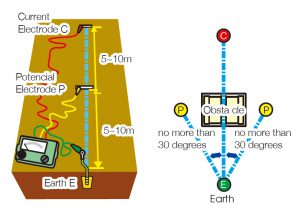Method for the Earth measurement of an earth electrode
Drive the auxiliary electrodes P and C into the ground on a straight line from the earth electrode under test E spacing them a minimum of 5 to 10 meters. If this is not possible due to the presence of obstacles, the auxiliary electrode P should be positioned on a line not diverging more than 30 degrees from the line between the earth electrode E and the auxiliary electrode C.
Notes:
- The ground into which the auxiliary earth electrodes are driven should be as humid as possible.
- High earth resistance of auxiliary earth electrode can impair the measurement accuracy, in such a case the Earth tester should indicate the problem. If the ground is gravel or sand, or if it is dry, a sufficient amount of water should be poured near the electrodes to ensure the ground has sufficient humidity.

- If the auxiliary earth electrodes cannot be driven into the ground, such as on concrete surfaces, lay down the electrode on the ground and pour water or place a wet cloth on the electrode to ensure good contact.
- Measurements cannot be performed if the ground is asphalt since it is a sort of insulator and no current can flow on it.
